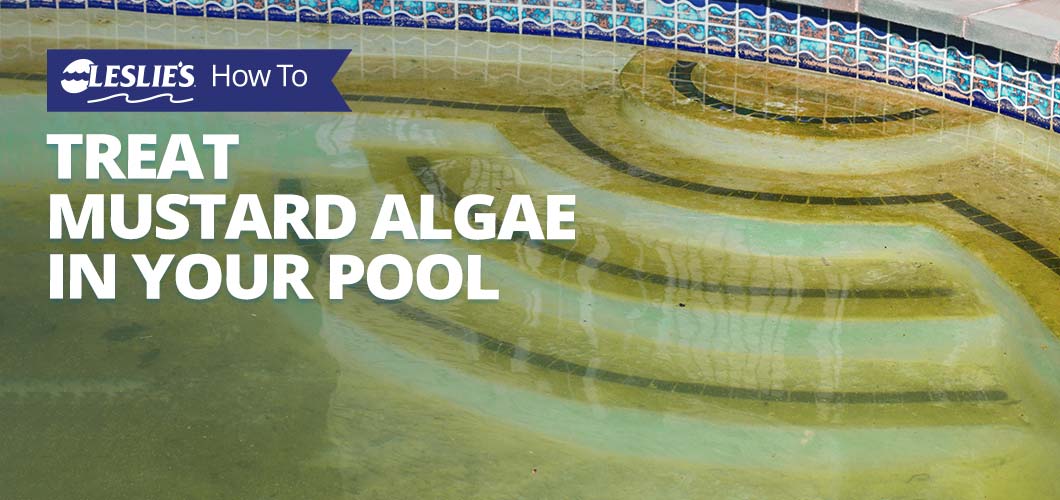
How to Treat Mustard Algae in Your Pool
When you think of mustard, the first thing that comes to mind is likely the mouthwatering, tangy condiment drizzled on hot dogs. But since this isn't the Food Network, this post is not about mustard, the food. This post is about the troublesome organic pool contaminant, mustard algae! In this post, we'll teach you how to treat mustard algae in your pool, and how to prevent it from coming back once it's gone.
Before we explain how to kill off the mustard algae in your pool, let's dive into what mustard algae is and where it comes from.
What is Mustard Algae?

Also called yellow algae, mustard algae is a cousin of the common green pool algae. With its yellowish hue and grain-like texture, mustard algae in your pool is often mistaken for sand, dirt, or pollen on the floor of the pool. Unfortunately, this resemblance can lead to mustard algae being undiagnosed, and therefore untreated. This can result in rapid growth and damage to your pool.
Typically found in warmer climates, mustard algae is not harmful to humans or animals in small doses. However, an overgrowth of it can harbor harmful bacteria, such as E. coli. It can also damage your pool surfaces if left unattended. Untreated mustard algae can cause serious pool surface staining, and may also cause issues with cloudy water.
Not only can mustard algae cling to surfaces inside your pool, it can also take root outside your pool. Mustard algae can travel out of your pool by attaching itself to pool toys, floats, and even swimsuits. If you suspect there is mustard algae in your pool, thoroughly wash all pool items to help stop the spread.
Where Does Mustard Algae Come From?
Mustard algae can enter your pool from airborne spores or ground contamination. Heavy rainstorms, flooding, strong winds, or other forms of pool water contamination can potentially open the door for mustard algae to enter your pool. Knowing how to manage your pool before and after a storm can stop the proliferation of algae in its tracks. For more information, check out our posts on how to maintain your pool before and after a storm.
Treating Mustard Algae
Now the fun part — getting the pesky golden gunk out of your pool. Mustard algae is a persistent and chlorine-resistant nuisance, much like its darker counterpart, black algae. But fear not, with a lot of pool shock and patience, you can successfully remove the mustard algae in no time.
Needed Supplies
Before tackling the mustard algae in your pool, head to your local Leslie's and grab the following supplies. If your pool is prone to developing algae, we recommend keeping these products on hand at all times.

- Pool Water Test Kit
- Water Balancing Chemicals
- Pool Brush
- Telescoping Pool Pole
- Yellow Out
- Leslie's Power Powder Plus 73
- Filter Cleaner
- Vacuum Head
- Phosphate Remover
- Algae Control
1. Check Filter and Run Pump
Give your pool filter a once-over, and make sure it's clean before you begin treating the mustard algae. Run a backwash cycle or rinse off the filter cartridge if necessary. Turn on your pool pump and let it run 24 hours per day for the entire mustard algae removal process.
2. Test and Balance Water
Test your pool water chemistry and adjust the levels as needed to meet the following recommendations. Notice there are some differences from the usual "ideal" ranges of water balance, especially when it comes to pH.
- pH: 7.8 or higher
- Total Alkalinity: 80–120 ppm (parts per million)
- Cyanuric Acid: 25–75 ppm
- FAC (Free Available Chlorine): 2.0–2.5 ppm
3. Brush the Pool
It's time to get your workout in for the day! Thoroughly brushing the mustard algae not only destroys its defenses, but it loosens the algae's hold on your pool surfaces and pushes it out into the water. This process makes it easier for chemicals to kill the algae. Use a wire-bristled brush on plaster, gunite, or concrete pool surfaces. If you have a vinyl-lined, pebble, or quartz pool, use a softer nylon brush.
4. Treat with Yellow Out
After meticulously brushing all the mustard algae in your pool, it's time to use the aptly named Yellow Out. Add 2 pounds of Yellow Out per 15,000 gallons of pool water. Pour 1 pound around the perimeter of your pool, starting where the algae is thickest. Pour the remainder directly over any problem areas.
It's important to follow dosing directions carefully when handling pool chemicals, so don't add more Yellow Out than is recommended. If you're unsure how many gallons of water are in your pool, check out our helpful pool volume calculator post. When you have finished adding the Yellow Out, wait 5 minutes before moving on to the next step.
5. Shock the Pool
Don't be shocked, but this next step requires some patience. As we mentioned above, the mustard algae in your pool is chlorine-resistant, so a normal dose of pool shock won't have much effect on it. Therefore, you're going to shock your pool three times, waiting at least 12 hours between each application.
For each round of shocking, use 2 pounds of Leslie's Power Powder Plus 73 per 15,000 gallons of water. After the first dose, wait 12 hours, then add another 2 pounds to your pool. After the second dose, wait 12 hours, and then add the third and final dose into the pool water.
6. Turn Pump Off and Clean Filter
Once the final round of shock has had 12 hours to fully circulate through your pool water, shut off your pump and clean your filter. Backwash your sand or D.E. filter, or clean the cartridge of your cartridge filter.
7. Turn Pump On and Add Clarifier
After cleaning your pool filter, turn the pump back on and test the FAC level. Once the FAC level is below 5.0 ppm, add a water clarifier, such as Leslie's Clear Aid or Leslie's Ultra Bright Advanced, to help remove the dead mustard algae in your pool and clear the water. If there is still mustard algae debris in your pool after adding a clarifier, vacuum the pool with your filter's multiport valve set to "waste" (if applicable).
8. Test and Balance Water
Finally, do a complete water chemistry test and adjust chemicals as needed. Once the chemicals are balanced, and the phosphate level is below 100 ppb (parts per billion), add Leslie's Perfect Weekly and Leslie's Algae Control — use both products weekly following the mustard algae treatment. Remember, the best way to get rid of mustard algae in your pool is to prevent it in the first place!
Speaking of...
Preventing Mustard Algae

Like many pool problems, mustard algae can be avoided by keeping your pool clean, sanitized, and healthy.
Test your pool water weekly and keep the chemistry levels — specifically pH, Total Alkalinity, Free Available Chlorine, and phosphates — properly balanced. Run your pool pump at least 8 hours each day to fully circulate the water, and shock your pool before and after heavy use to keep organic contaminants at bay. Incorporate algae-fighting products like Leslie's Perfect Weekly and Leslie's Algae Control into your weekly routine for extra defense.
Mustard algae can happen to even the best pool owners. If the frustrating organic contaminant is starting to grow in your pool, nip it in the bud by following the treatment steps above. Most importantly, keep it away for good by sticking to a weekly pool cleaning and water testing routine. Stop by your local Leslie's if you have any questions or wish to speak to one of our friendly pool experts.